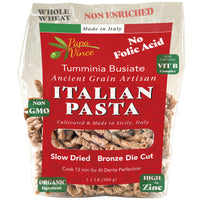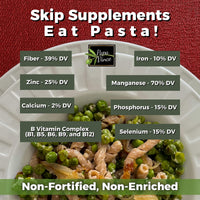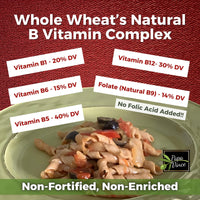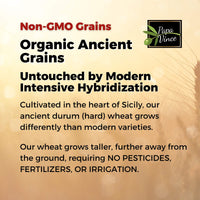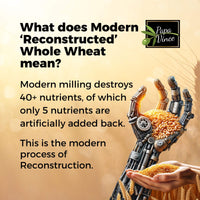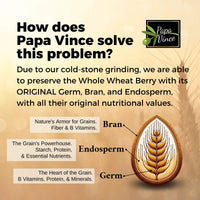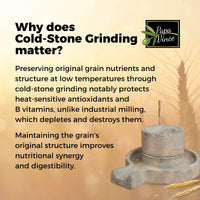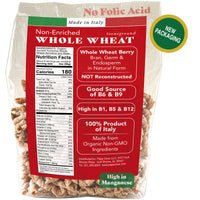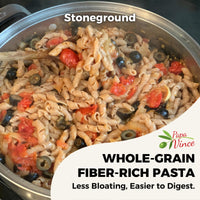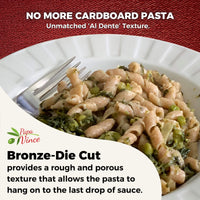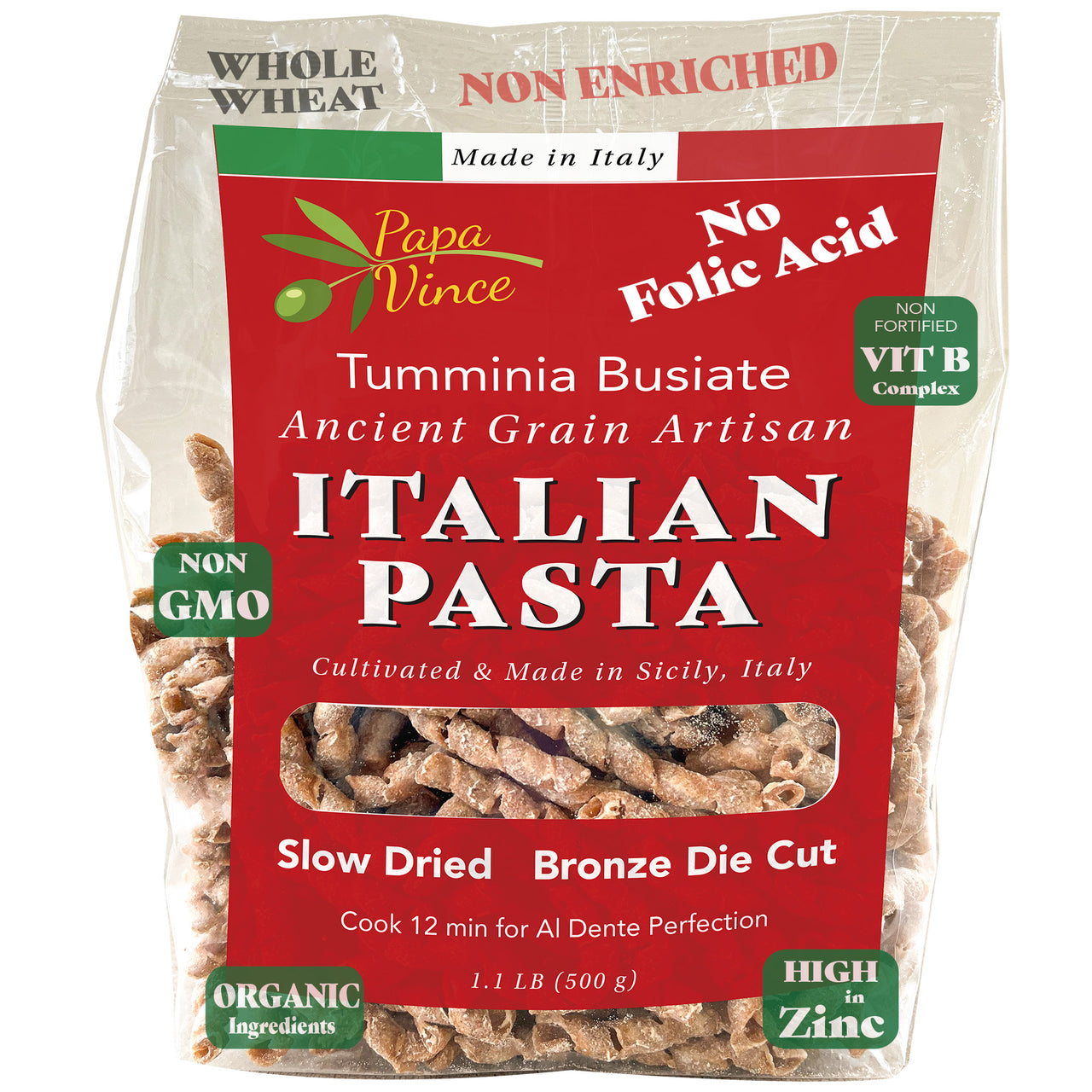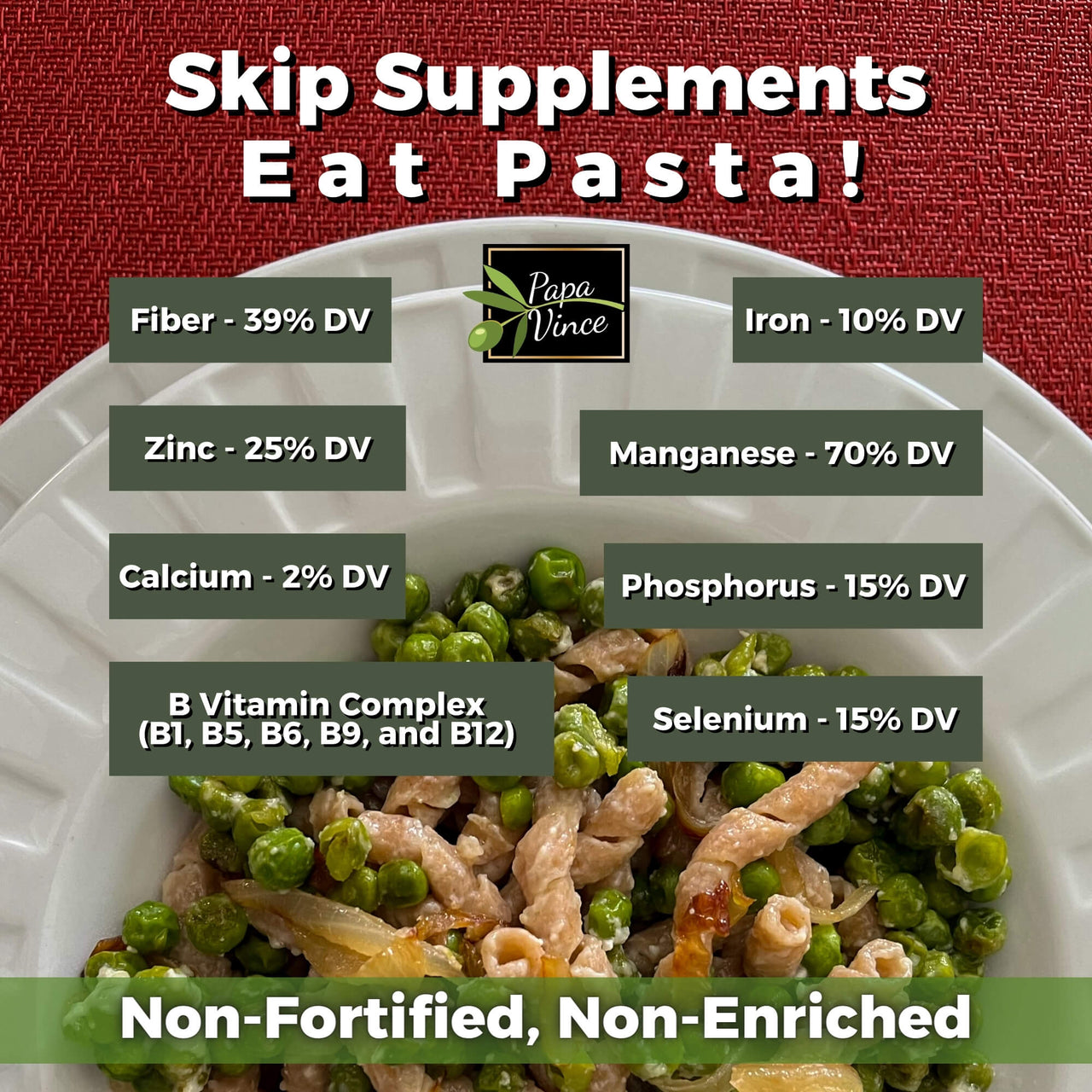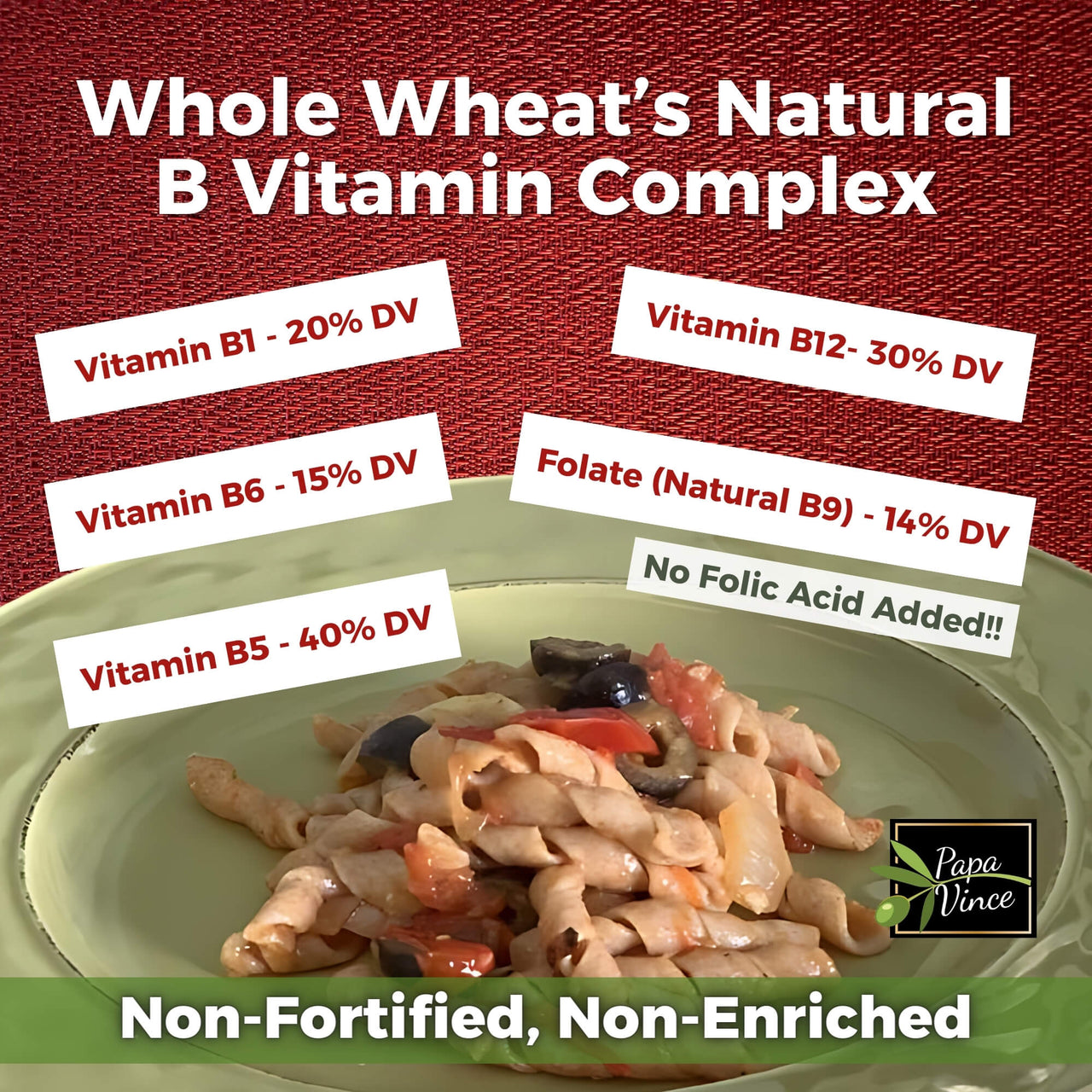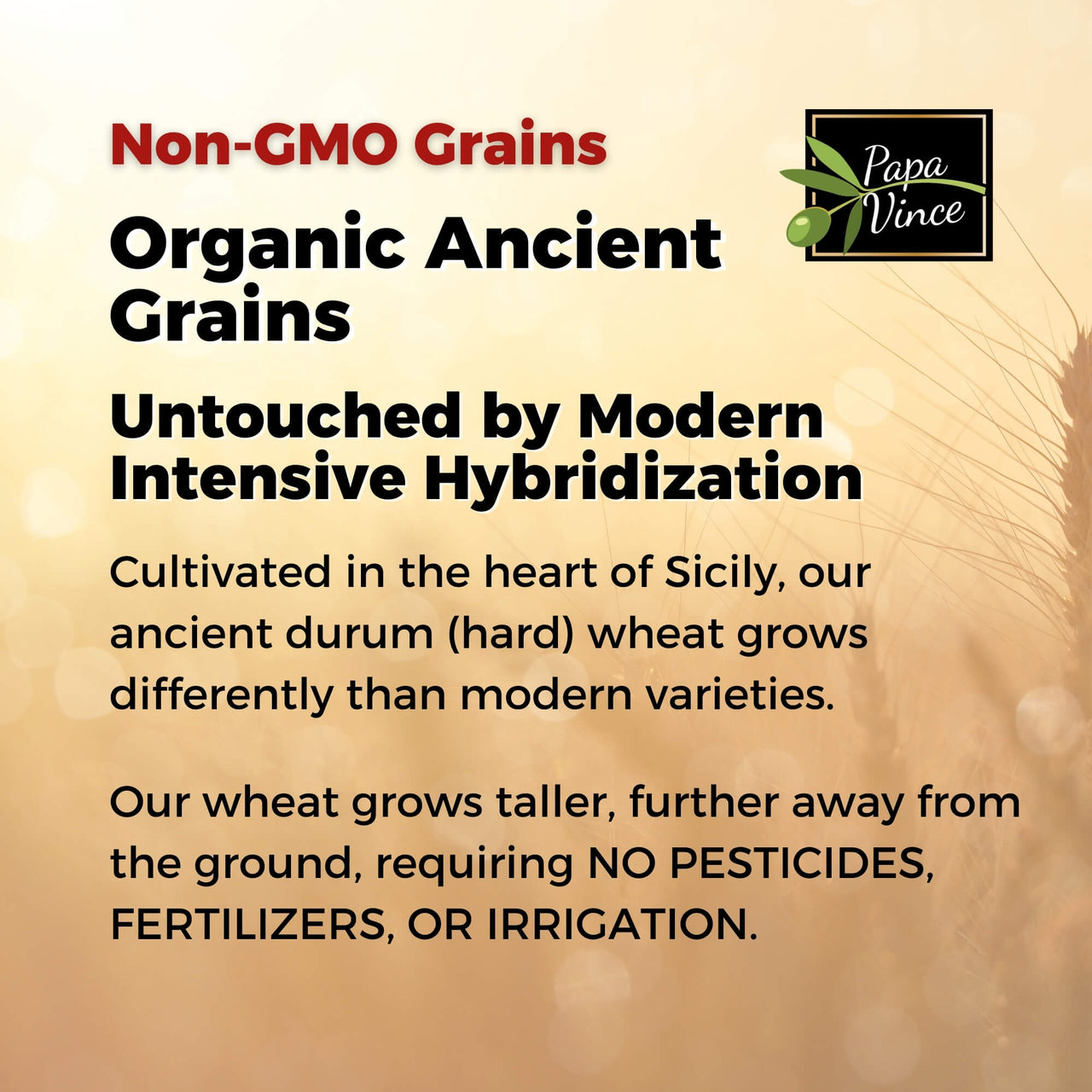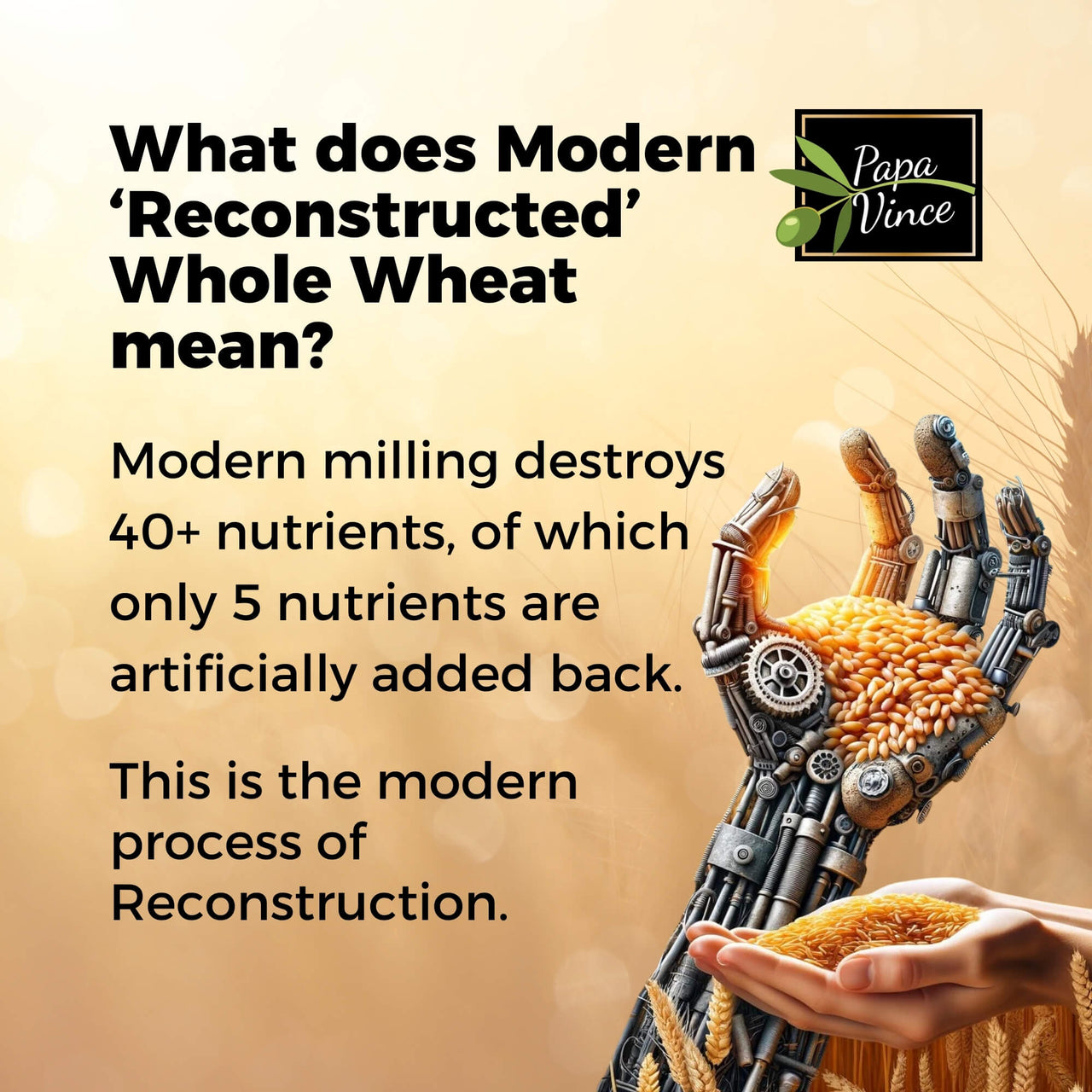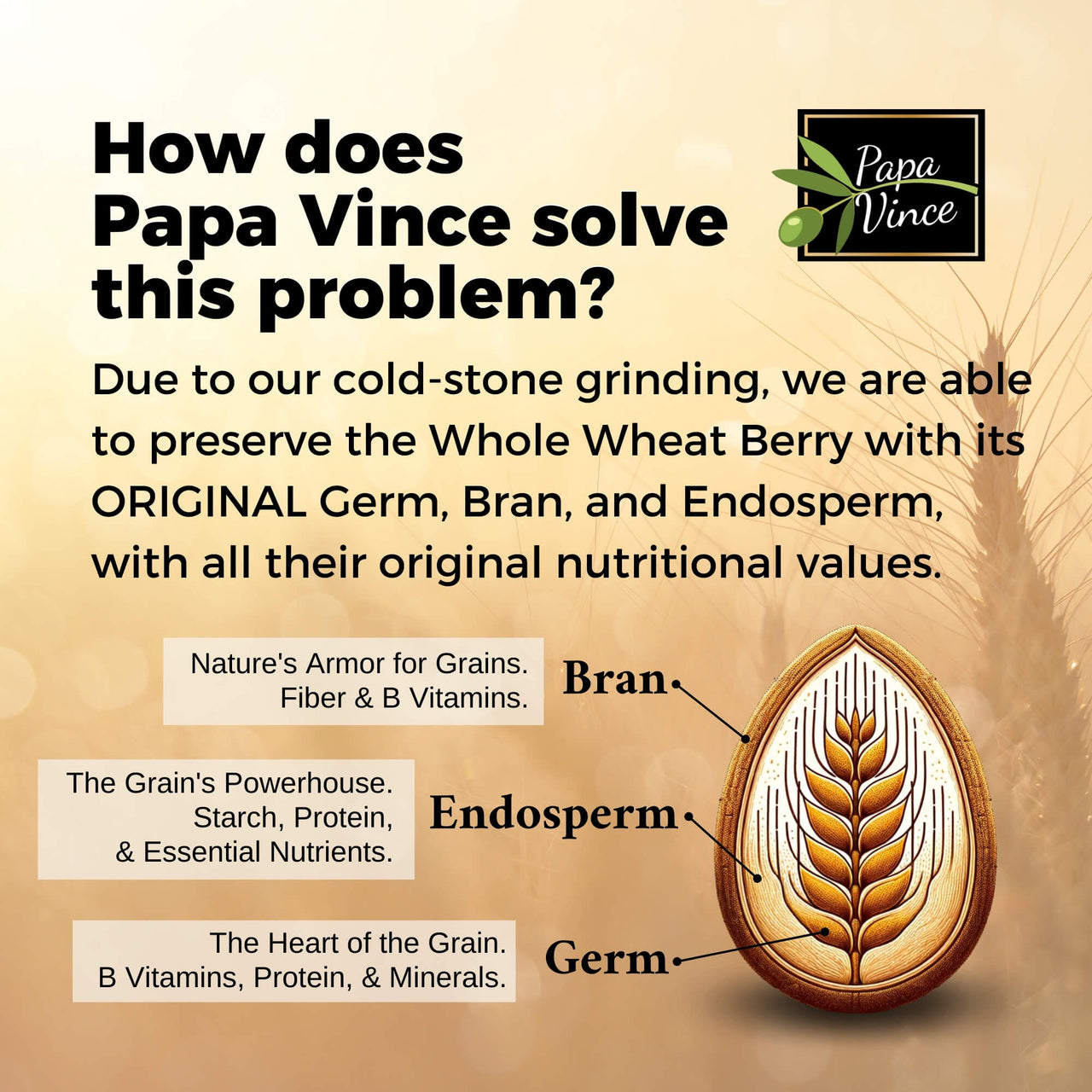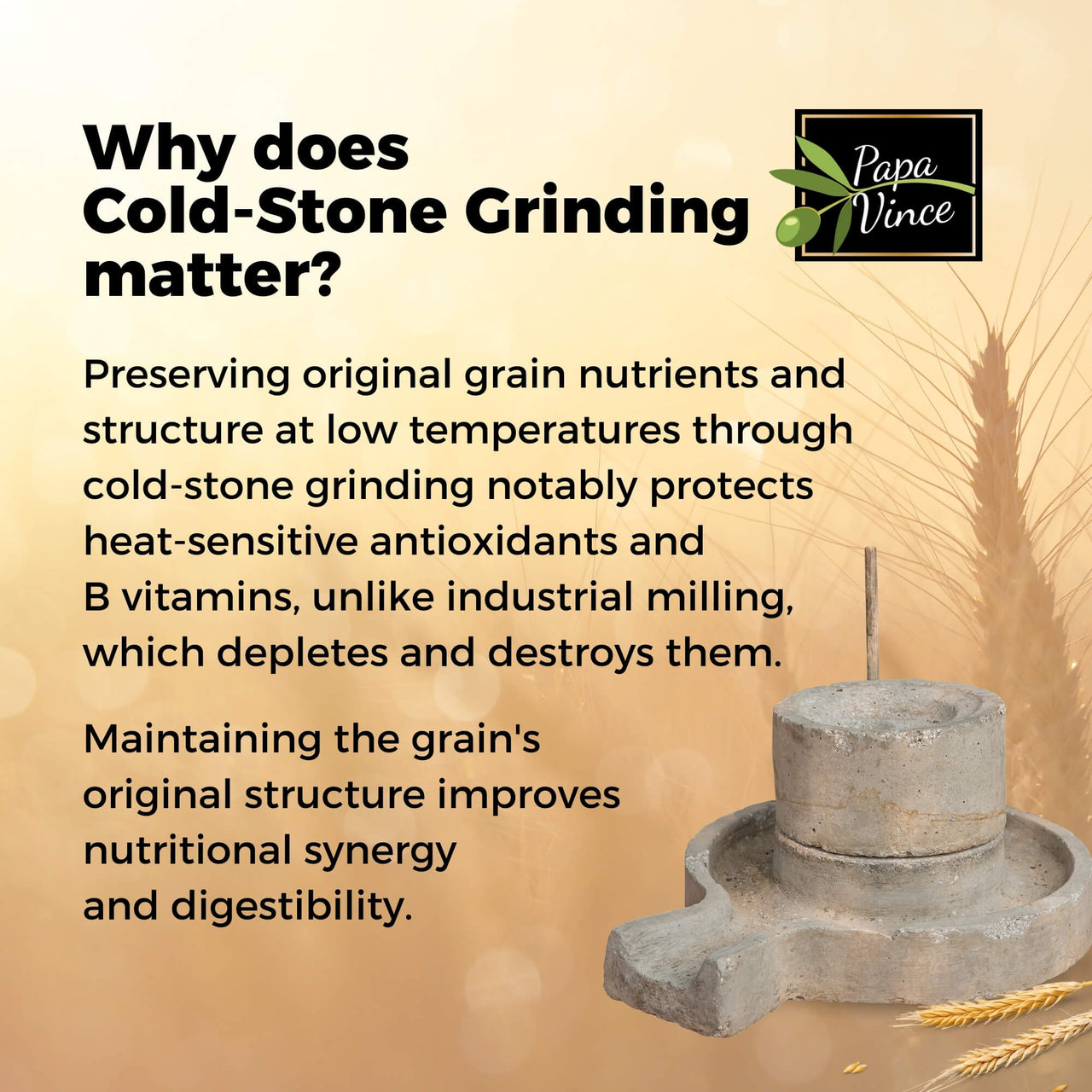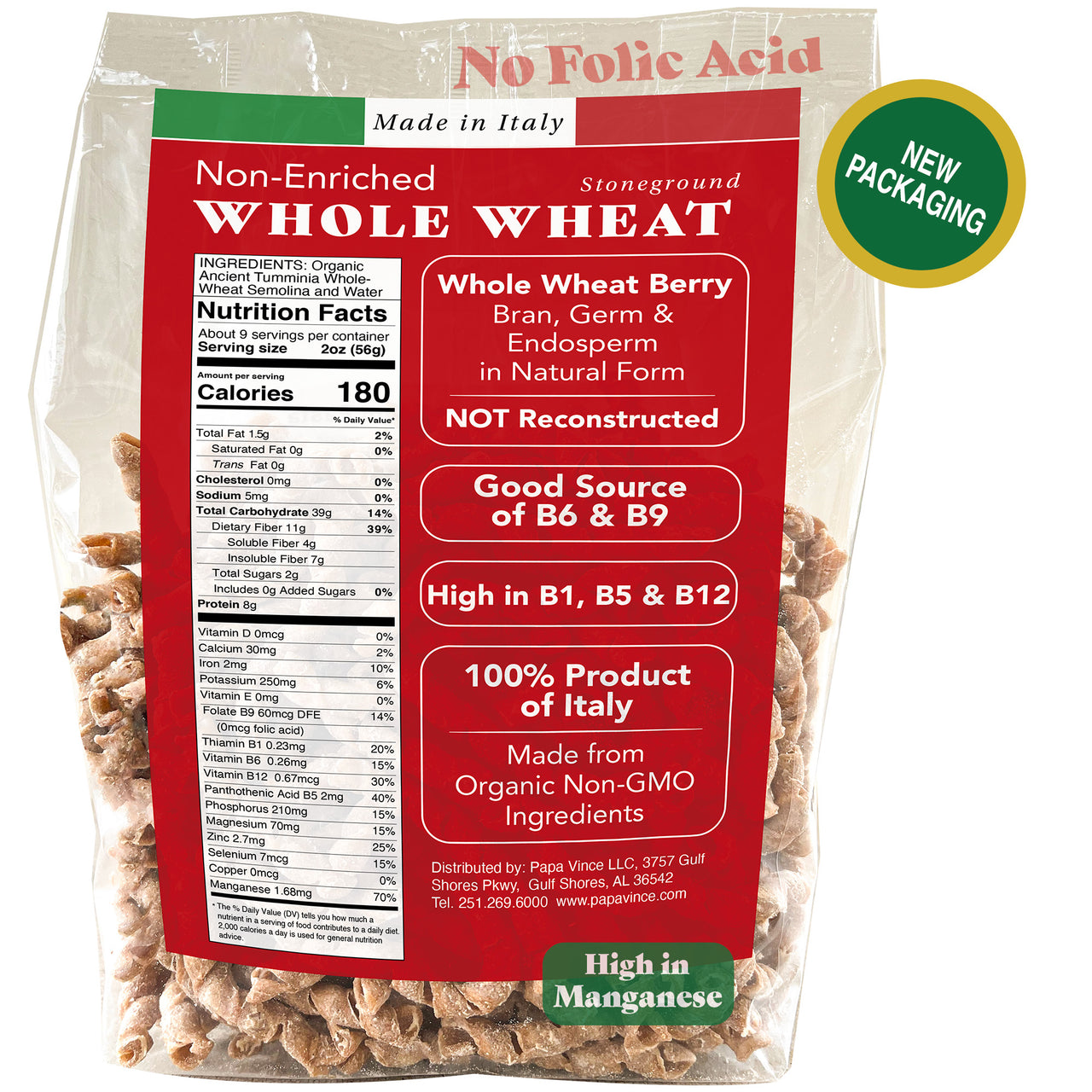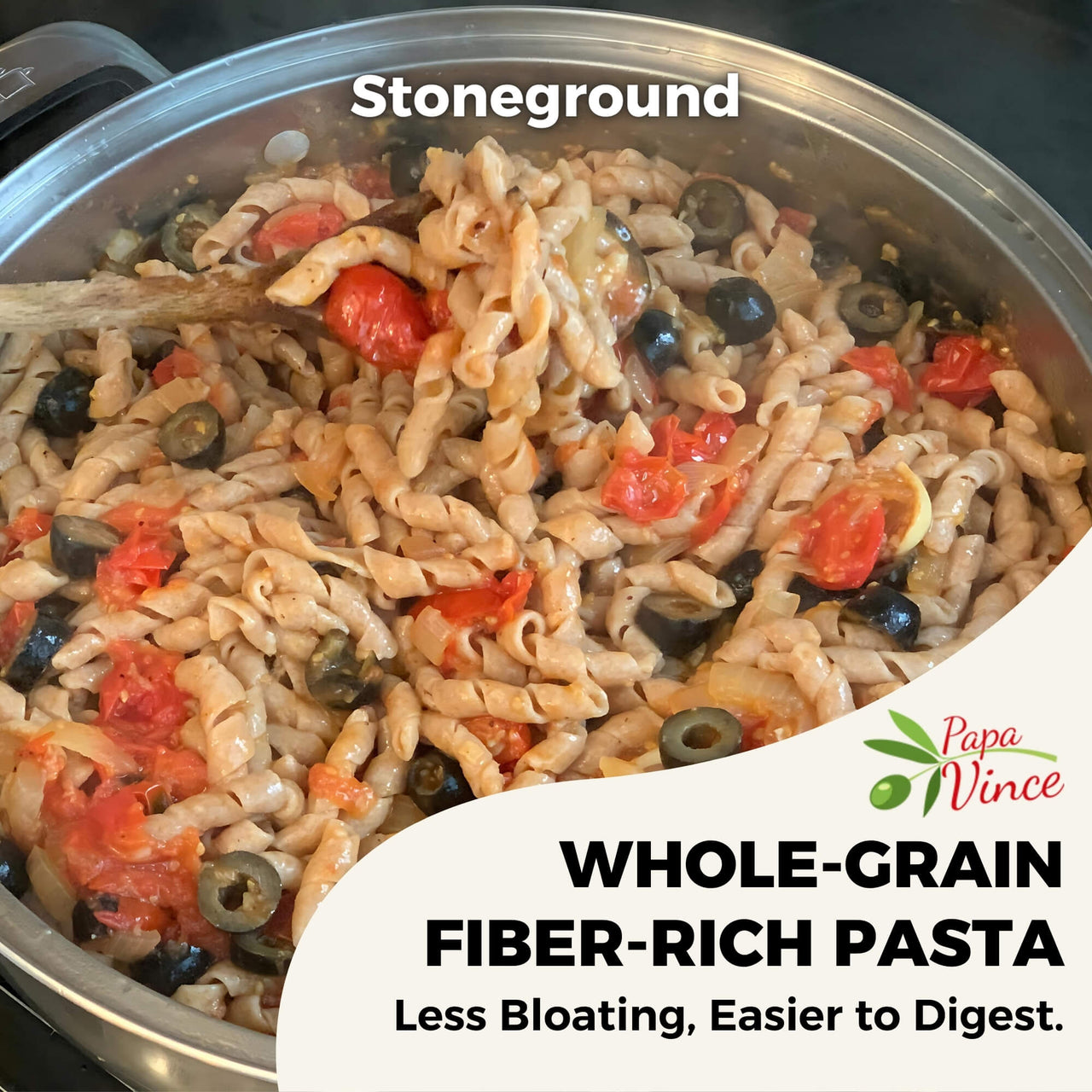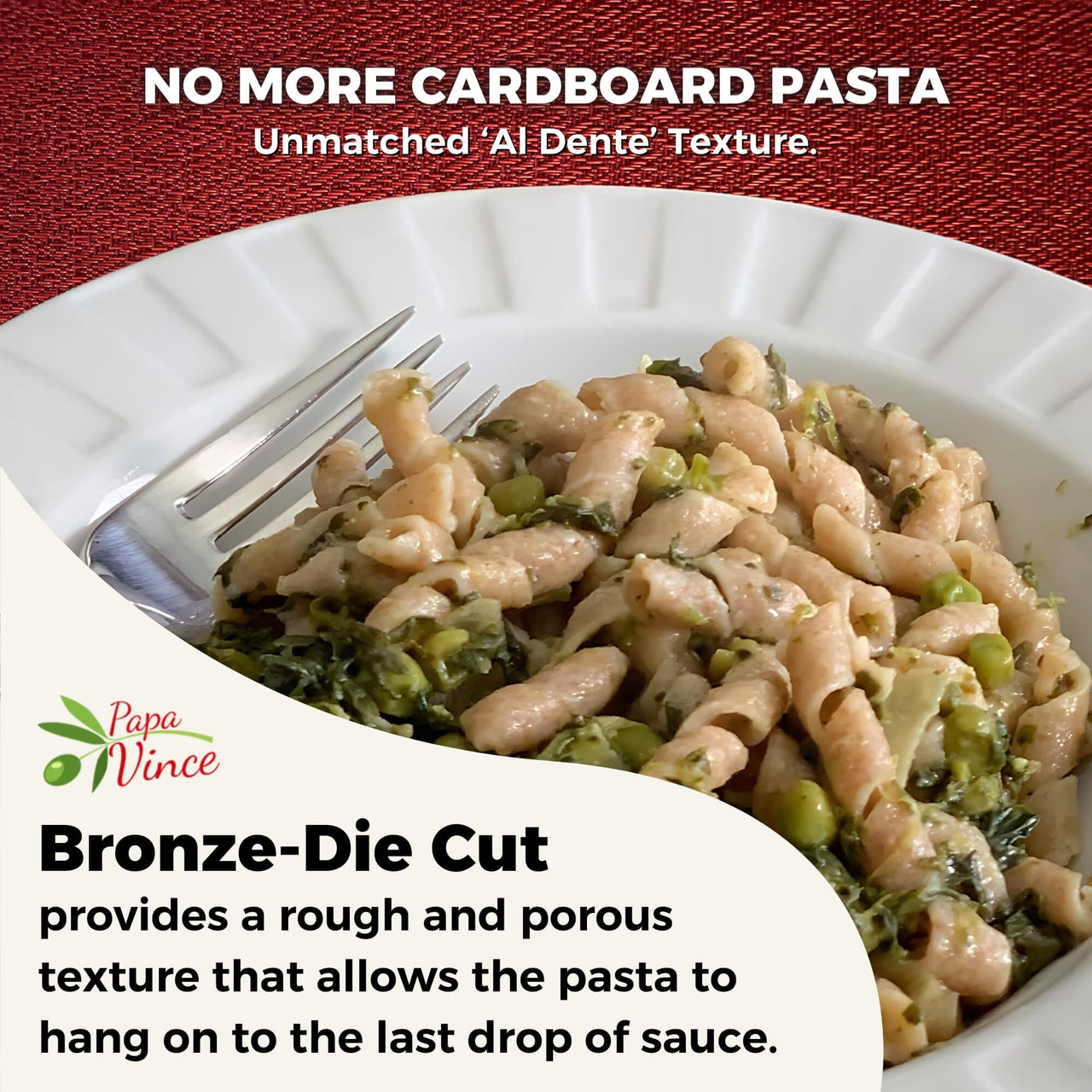SKIP SUPPLEMENTS - EAT PASTA!
EAT GOOD.
Bid farewell to bland, odorless, mass-produced pasta stripped of its essence.
Say hello to the aromatic nuttiness and hearty, chewy texture of pasta crafted from ancient grains, untouched by modern technology.
Experience the gratifying chewiness and rich complexity that only stone-ground ancient grain pasta can deliver, guaranteeing not just remarkable flavor but also preserving the innate nutritional value of each grain.
UNTOUCHED
BY MODERN TECHNOLOGY
_____________
FEEL GOOD.
Say goodbye to the post-meal fatigue, bloating, and sugar spikes that often come with refined, enriched pasta dishes.
Papa Vince's pasta are made from Ancient Wheat Grains that deliver superfood levels of vitamins and minerals—all found naturally in their unprocessed state and at their optimal percentages, as nature intended.
UNPROCESSED
SUPER FOOD
_____________
THRIVE RAW.
Crafted from the fertile lands of Sicily, our pasta is naturally endowed with the full spectrum of B vitamins found in durum whole wheat—B1, B2, B3, B5, B6, B9, and B12—essential for maintaining energy levels and overall vitality.
Unlike standard U.S. pasta, which relies on synthetic nutrients like niacin (B3), thiamin (B1), riboflavin (B2), folic acid (B9), and iron, our pasta boasts
17 NATURALLY OCCURRING VITAMINS & MINERALS,
including folate (B9), ensuring a wholesome and nourishing experience with each bite.
NO FOLIC ACID or B-VITAMIN FORTIFICATION
_____________

Raw B-Vitamin Energy
Benefit of the Full Spectrum of
Naturally Occurring B-Vitamin Complex
These naturally occurring vitamins foster a unique synergy that propels our bodily functions to new heights.
- Thiamine (B1), Riboflavin (B2), Niacin (B3), and Pantothenic Acid (B5) join forces to fuel our energy production, turning meals into vitality.
- Pyridoxine (B6), Folate (Natural B9), and Cobalamin (B12) are the pillars of cellular health and function, repairing and regenerating to keep our bodies in prime condition.
- B1, B6, B9, and B12 also play crucial roles in brain health and the support of the nervous system, ensuring our minds stay sharp and responsive.
- Folate (Natural B9) and B12 are particularly essential for the production of red blood cells and vital for oxygen transport.
- B2, B3, and B5 are the key regulators of our metabolism and hormones, maintaining a delicate balance that sustains our overall well-being.
SEE WHAT OUR CUSTOMERS ARE SAYING
ANCIENT WHOLE WHEAT: NUTRIENT-RICH POWER

ANCIENT GRAINS
- Ancient Grains have a superior nutritional profile compared to modern, mass-produced wheat varieties.
- Ancient Grains have higher levels of vitamins, minerals, and proteins, all in their natural form. No fortification needed.
- Ancient Grains are high in antioxidants & phytonutrients, which are not as prevalent in modern wheat.
- Ancient Grains remain unchanged for centuries.
- Ancient Grains grown strong & tall in harsher climates & poorer soils with no herbicides, no pesticides, no insecticides.
COLD-STONE GRINDING
- Cold-stone grinding preserves all the parts of the wheat: bran, endosperm & wheat germ.
- Cold-stone grinding preserves the wheat's heat sensitive nutritional properties, including its natural proteins, omega-3 fatty acids, and fiber content.
- Cold-stone grinding preserves the wheat's original structure and the nutritional synergy of its components
- Cold-stone grinding preserves the wheat's integrity enhances flavor and digestibility.
- Papa Vince offers a superior whole wheat pasta made from original components instead of synthetic vitamins, synthetic fibers, synthetic proteins, and synthetic nutrients.
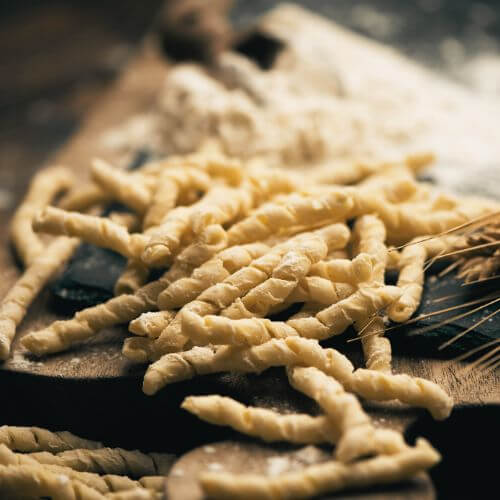
SLOW DRYING
- Slow drying allows moisture to evaporate gently, preserving the pasta's natural starch content and structure.
- Slow drying preserves the pasta's heat-sensitive nutrients, including vital vitamins (specifically B Vitamins) and antioxidants.
- Papa Vince Ancient Grain Pasta offers a nutritionally superior profile compared to its high-temperature, rapidly dried counterpart, which lacks nutrients.
FAQ - The Health Power of Ancient Grains
Can Switching to Ancient Grains Improve Your Dietary Habits?
Unlike modern wheat, which has been selectively bred for higher gluten strength and yield, ancient grains offer a gluten quality that is inherently less inflammatory and more digestible.
This makes them a superior choice for those looking to improve their dietary habits. Modern grain hybridization and gene alteration have primarily affected wheat's protein content, resulting in ancient grains having a weaker gluten index in their more naturally occurring form.
Additionally, the protein content is why ancient grain pasta, made in the traditional way, preserves superfood levels of nutrition in terms of vitamins and minerals.
What Nutritional Edge Do Ancient Grains Hold Over Modern Ones?
Ancient grains hold a significant nutritional edge over modern ones.
They are not just about lower gluten toxicity; they are nutritional powerhouses enriched with antioxidants, vitamins, minerals, and micronutrients.
Research underscores the benefits of ancient grains for their digestible gluten and reduced levels of immunogenic proteins, which contribute to decreased inflammation and improved tolerance for gluten-related disorders.
Furthermore, the elevated presence of secondary metabolites and polyphenols in ancient grains enhances their metabolic and clinical benefits, underscoring their nutritional superiority.
Why Are Natural Proteins and Omega-3s More Potent in Our Pasta
Our pasta's standout nutritional profile, featuring highly potent natural proteins and omega-3s, stems from our commitment to the age-old technique of cold stone grinding.
This artisanal process is the cornerstone of our approach, ensuring the wheat's vital nutrients—natural proteins, omega-3 fatty acids, antioxidants, and fiber—are preserved in their most wholesome form.
Unlike modern processing methods, which often strip away these essential nutrients, our traditional grinding technique safeguards the wheat's nutritional integrity.
This meticulous process preserves our pasta's dense nutritional content and imbues it with an unparalleled 'al dente' texture and a harmonious blend of robust, earthy flavors complemented by a hint of subtle sweetness.
At Papa Vince, we believe in honoring the wheat's soul by retaining its healthful essence, offering you a pasta experience that is not only delicious but deeply nourishing
FAQ - Why Ancient Grains Should Be Your Gut's New Best Friend
Can Ancient Grains Be a Healthier Option for Gluten Sensitivities?
Absolutely, ancient grains represent a healthier choice for individuals with gluten sensitivities due to their unique gluten structure, which is different from modern wheat. Because of ancient grain’s inherent biodiversity, this particularly distinguishes the genetic spectrum compared to modern wheat, that has been hybridized for very few gluten gene diversity.
This difference results in a less elastic and potentially less inflammatory response, making ancient grains particularly beneficial for those with gluten sensitivities or anyone interested in anti-inflammatory dietary choices.
The distinct gluten composition in ancient grains, such as spelt, farro, and einkorn, may be easier to digest for some people, reducing the risk of discomfort or adverse reactions commonly associated with gluten consumption.
Moreover, these grains offer a wealth of nutritional benefits, including high levels of fiber, protein, vitamins, and minerals, contributing to a well-rounded diet. Their diverse nutritional profile can support overall health, offering an array of antioxidants and phytonutrients that promote digestive health, improve metabolic functions, and may even reduce the risk of chronic diseases.
For those navigating gluten sensitivities, integrating ancient grains into their diet can open up new avenues for enjoying a variety of foods without compromising on taste or nutritional value.
Why Is the Gluten in Ancient Grains Considered Less Inflammatory?
Ancient grains possess a gluten structure inherently different from that of modern wheat, making it less elastic and potentially less inflammatory. This characteristic is especially beneficial for individuals with gluten sensitivities or those pursuing anti-inflammatory dietary choices.
Ancient grains' less elastic gluten suggests a healthier option, aligning with the needs of those looking to maintain a balanced and sensitive diet.
Can Switching to Ancient Grain Pasta Ease Gastrointestinal Issues?
Incorporating ancient and heritage grains into one's diet could improve health. Clinical trials have demonstrated that these grains can diminish inflammation, bolster metabolic health, and even assist individuals with specific gastrointestinal issues.
The shift towards ancient grains is more than a dietary trend; it's a return to the roots of nutrition and wellness. Papa Vince’s Ancient Grain Pasta stands as a testament to the timeless virtues of ancient grains, inviting you to experience enhanced nutrition, richer taste, and a profound connection to age-old culinary practices with every bite.
Why is low-temperature slow dried pasta easier to digest?
Our meticulous low-temperature slow drying process is designed to maintain the natural structure of gluten within the pasta, making it significantly easier to digest. This thoughtful preservation means that our pasta not only offers a higher nutrient content but also a more agreeable experience for your digestive system compared to mass-produced options. With Papa Vince's pasta, you enjoy both the rich flavors of Sicily and a meal that's kind to your body.
FAQ - The Revival of Busiate Artisanal Pasta
What's the difference between Italian and American Non-Enriched Wheat?
The difference between Italian and American non-enriched wheat largely hinges on cultivation practices and regulations regarding GMOs and pesticide use, notably glyphosate (herbicide).
Italian wheat, especially non-enriched varieties, is typically grown under stringent European regulations that favor non-GMO crops and significantly restrict the use of glyphosate and other chemicals. This approach ensures that the wheat remains as natural and untouched as possible, preserving its nutritional integrity and flavor.
In contrast, even when non-enriched, American wheat may still be produced from GMO strains and is more likely to be exposed to glyphosate and other pesticides during cultivation. These practices can raise concerns about potential health impacts and environmental sustainability. The use of glyphosate, in particular, has been a point of contention, with debates over its safety and effects on human health and the ecosystem.
Choosing Italian non-enriched wheat means opting for a product that aligns with stricter standards for GMOs and pesticide use, offering a cleaner, potentially safer ingredient for consumers who prioritize natural and environmentally friendly agricultural methods.
Stone-Ground vs. Refined: What Difference Does It Make in Our Pasta?
Far from the stripped-down essence of refined flours, our durum wheat semolina is a testament to whole grains' integrity. By choosing not to refine our semolina, we ensure that the pasta retains the complexity of flavors and nutrients that refined counterparts often lose.
This commitment to maintaining the semolina’s natural state allows us to deliver a product that tastes better and aligns with our vision of offering healthful, nourishing food.
Why Choose Pasta Made with Ancient Grain Wheat Semolina?
Indulge in a slice of Italy with our Sicilian Ancient Grain Wheat Semolina Pasta, a nod to the timeless traditions of Italian cuisine. Celebrating the full, untouched essence of the wheat grain, our pasta is made from durum wheat semolina, known for its golden hue and rich, nutty flavor.
This choice reflects our commitment to preserving the grain's wholesome goodness and natural aroma, offering an authentic taste of Sicilian heritage in every bite.
How Do We Keep Antioxidants and Fiber Intact in Every Bite?
Our secret to preserving the wheat's soul lies in the age-old art of cold stone grinding. This traditional method keeps the natural proteins, omega-3s, antioxidants from the germ, and fiber from the bran intact, unlike modern processing techniques that can diminish these essential nutrients.
Papa Vince’s Pasta boasts an unparalleled 'al dente' texture and a perfect balance of robust, earthy tones and a subtle sweetness—thanks to our dedication to preserving these vital nutrients.
FAQ - Agriculture Without Modern Intervention
Why are Ancient Grains from Sicily the Best?
In countries like Canada, France, and the USA, the battle against fungus and mycotoxins is a significant concern for wheat cultivation, often compromising the integrity of the whole wheat berry, forcing them to use fungicides.
Did you know certain people mistake gluten sensitivity with being allergic or sensitive to fungicides?
However, Sicily stands apart in this regard, thanks to its dry and hot climate that naturally discourages fungus growth. This favorable environment allows for the preservation of the entire whole wheat berry without the worry of mycotoxin contamination.
The unique climatic conditions of Sicily provide an ideal setting for growing wheat that is both healthy and pure, ensuring that the risk of fungus-induced damage is minimized and the quality of the wheat remains uncompromised.
At Papa Vince, we Lab Test all our products to ensure no mycotoxin contamination and no fungicides are used during farming.
Why can Ancient Grains from Sicily be Cultivated without Pesticides?
Sicilian ancient grains, celebrated for their extraordinary biodiversity and resilience, flourish without the need for fertilizers, pesticides, or artificial irrigation.
Genetically akin to einkorn wheat, humanity's oldest known wheat, these grains provide a gluten-sensitive option, yielding a nutritious and digestible whole wheat berry.
Science is now uncovering the potential of these resilient grains, which have flourished under the influence of diverse cultures throughout history.

OUR FAMILY COMMITMENT
All our Pastas follow the same quality guidelines
Papa Vince Pasta
Non-Enriched
Non-Fortified
Cold-Stone Grounded
Non-GMO Ancient Grains
No Glyphosate used in farming practice
No Pesticides
No Herbicides
No Insecticides
No Irrigation - Conserves Water
No Synthetic Fibers
No Synthetic Vitamins
No Bleaching
Generic Pastas
Enriched
Fortified
High-Temperature Steel Milled
Modern Grains
With Glyphosate used in farming practice
With Pesticides
With Herbicides
With Insecticides
With Irrigation
With Synthetic Fibers
With Synthetic Vitamins
With Bleaching
All the A's to your Q's About Our Non-Enriched Pasta
How do I know if pasta is enriched or non-enriched?
To determine if pasta is enriched or non-enriched, closely examining the ingredient list on the packaging is key:
• Look for Key Words: If "enriched" appears before "wheat flour" or "semolina flour" (e.g., "enriched wheat flour" or "enriched semolina flour"), the pasta is enriched. This indicates that after processing, vitamins and minerals have been added to the flour.
• Check the First Ingredient: IThe first ingredient listed can also be a giveaway. Ingredients like "wheat flour" or "semolina flour" without the prefix "enriched" usually indicate non-enriched pasta.
• Identify Added Nutrients:Even if "enriched" is not in the first ingredient, scan for added vitamins and minerals further down the list. These can include iron, folic acid (manufactured vitamin B9), niacin, thiamine mononitrate (vitamin B1), and riboflavin (vitamin B2). Their presence means the pasta is enriched.
In the United States, most pastas are enriched to meet dietary standards. However, there are now more non-enriched options available, especially from imported and specialty brands like Papa Vince. This is good news for those who prefer more natural and traditional pasta choices.
Is all pasta enriched?
No, not all pasta is created equal—especially when it comes to enrichment.
In the United States, many wheat products, including pasta, are commonly enriched as part of nutritional fortification efforts, adding back vitamins and minerals lost during processing. However, across Europe, the approach to pasta is different; there is no widespread practice of fortification or enrichment, allowing the natural qualities of the wheat to shine through.
This distinction highlights a broader diversity within the pasta world, where choices range from the nutrient-enhanced (enriched pasta) to the purely traditional (non-enriched pasta).
Enriched pasta is produced by adding vitamins and minerals, like iron, folic acid, and B vitamins, back into flour after its initial processing, which removes the wheat kernel's bran and germ. This enrichment compensates for the loss of natural nutrients during high temperature, industrial milling, to give wheat as a staple some level of a nutritional profile by “fortifying” synthetically.
On the other hand, Non-Enriched Pasta does not undergo the synthetic, nutrient addition process after milling. It can be made from:
• Refined Wheat Flour: milled to remove the bran and germ, leading to a product with a finer texture and lighter color. While it may offer a smoother mouthfeel, it lacks many nutrients in whole grain flour.
• Whole Wheat Flour: made using the entire wheat kernel, including the bran, germ, and endosperm. This results in a higher fiber, protein, vitamins, and minerals product than pasta made from refined wheat flour.
Our pasta, for example, is made with durum whole wheat semolina, falling into the non-enriched category. It retains the natural nutrients of wheat, including fiber, proteins, and vitamins, without the need for artificial enrichment.
What is non-enriched pasta?
Non-enriched Pasta refers to Pasta that does NOT undergo an enrichment process adding specific nutrients. It relies on the inherent qualities of artisanal traditional pasta-making techniques to deliver naturally occurring nutrition, distinctive taste, texture, and cooking characteristics.
Is organic pasta enriched?
Whether organic pasta is enriched or not depends on the specific brand and product. Organic simply refers to the way the ingredients are grown and processed, not whether they are fortified with additional nutrients. Here's what you need to know:
Enrichment and Organics:
• Organic standards don't regulate enrichment: Organic certification ensures adherence to specific growing and processing practices but doesn't dictate whether nutrients are added back after processing.
• Both options exist: You can find organic pasta that is both enriched and non-enriched.
Checking Enrichment:
• Read the ingredient list: The first ingredient will typically be "enriched wheat flour" or "wheat flour". If the first ingredient is enriched, the pasta contains added nutrients.
• Look for keywords: Words like "whole wheat" or "100% whole wheat" indicate no enrichment.
Whole Wheat vs. Refined Flour:
Even organic pasta can be made with refined flour, which naturally loses nutrients during processing. Look for whole wheat options, like Papa Vince, for higher fiber and nutrient content.
What's the difference between enriched and non-enriched pasta?
The main difference between enriched and non-enriched pasta lies in their nutrient content:
Enriched Pasta
• Has vitamins and minerals added back in during processing. This is done to replace nutrients lost when the wheat kernel is milled into flour, a process that removes the bran and germ (the most nutritious parts).
• Typically contains added iron, folic acid, and B vitamins.
• Can be made with refined wheat flour (white pasta) or whole wheat flour.
• Generally has a smoother texture and milder flavor compared to non-enriched pasta.
Non-Enriched Pasta
• Doesn't have additional vitamins and minerals added back in.
• May be made with:
- Refined wheat flour: This flour has lost most of its fiber and nutrients during milling.
- Whole wheat flour: This flour retains the bran and germ, making it higher in fiber, protein, vitamins, and minerals.
• Generally, it has a denser texture and more "grainy" flavor than enriched pasta.
Is Italian Pasta enriched?
Whether Italian pasta is enriched varies based on several key factors:
• In Italy: there is a strong commitment to preserving the nutritional value through natural sources and traditional culinary methods. This is done to honor the natural richness of durum wheat semolina and avoid widespread enrichment, in favor of utilizing the grain's inherent protein and vitamins.
• Exported Pasta: Italian pasta exported abroad may be subjected to the destination country's fortification regulations, requiring enrichment in some cases.
• Brand and Product Variations: different brands and types of pasta from Italy might have varying enrichment statuses influenced by local regulations, export requirements, and consumer preferences.
• Whole Wheat vs. Refined Flour: the choice between durum wheat semolina (typically whole wheat) and refined flour affects the need for enrichment, with whole wheat options naturally richer in nutrients.
Papa Vince pasta is made with whole wheat semolina, providing a healthier and authentic Italian taste. It remains unenriched, offering a fiber-rich option that honors classic tradition over common, mainstream fortification practices.
Is Durum Wheat enriched?
Durum wheat, in its natural form, is not enriched, which means it does not have vitamins and minerals added back in after processing. The use of durum wheat varies across different products, influencing their enrichment status:
• Durum Wheat Semolina: This is a coarsely ground flour traditionally used in Italian pasta. It retains most of the natural nutrients found in the wheat kernel, including the bran, germ, and endosperm, and is generally not enriched. Semolina is prized for its rich nutrient content and the robust texture it imparts to pasta.
• Durum Wheat Flour: Durum wheat flour is a more refined version of semolina, which may result in the loss of some bran and germ. Depending on the regulations of the country and the product, this flour may be enriched to meet certain nutritional standards or consumer expectations.
Papa Vince's pasta, specifically, is crafted using non-enriched durum wheat semolina. This choice ensures that the pasta retains the wholesome goodness of the entire wheat berry, including the bran, germ, and endosperm. This commitment to using non-enriched, durum whole wheat semolina aligns with our mission to offer products that are nutritious and authentic.
When assessing whether a durum wheat product is enriched, always scrutinize the ingredient list. Look for mentions of "enriched flour" or "enriched semolina" and check for added enrichment ingredients such as niacin, folic acid, and iron.
Is Whole Wheat Pasta less processed?
In the US, whole wheat pasta is not necessarily less processed due to the common practice of adding back nutrients that were stripped away during the processing phase.
Often, what is marketed as "whole wheat" pasta might better be described as "reconstructed whole wheat." This means that the germ and bran, integral components of the wheat grain that are removed during initial processing, are later reintroduced as isolated ingredients.
This process differs significantly from traditional, artisanal methods, where the whole grain—with all its parts intact—is preserved throughout the entire production, ensuring a less processed final product.
This traditional, artisanal approach not only maintains the nutritional integrity of the pasta but also aligns more closely with what consumers might expect from a product labeled as “whole wheat”.
Why is pasta healthier in Italy than in America?
Pasta is often considered healthier in Italy than in America due to differences in ingredients and processing.
Authentic Italian pasta is made using whole grains and avoids enrichment or fortification, which helps to retain the natural nutrients of the wheat. Papa Vince's pasta is an example of going back to artisanal, traditional methods. Moreover, employing traditional Italian pasta-making techniques, such as slow drying at low temperatures, helps preserve the nutritional value and flavor of the pasta.
In the United States, there's a pronounced lean towards Big Food's modern, industrial methods in pasta production. American pasta is often crafted from refined flour, subjected to high-temperature drying in industrial settings, and commonly enriched with vitamins and minerals. This approach significantly alters the pasta's natural nutritional profile, distancing it from the traditional, artisanal practices that prioritize the preservation of inherent nutrients.
So, to determine the nutritional quality of pasta, regardless of its origin, it's essential to check the ingredient list for keywords like "enriched flour" or "enriched semolina" and look for products that maintain the grain's natural nutrient profile.
How can you tell pasta is high quality?
Judging the quality of pasta can be tricky, but there are a few key pointers you can use:
Appearance:
• Color: High-quality durum wheat pasta will have a slightly off-white or light yellow color, not an intense yellow. An intense yellow color often indicates the use of lower-quality wheat or added coloring.
• Texture: The pasta should look smooth but not overly polished. A slightly rough texture suggests the bran wasn't completely removed, indicating whole wheat or high-quality semolina.
• Shape: Look for consistent shapes without breaks, cracks, or deformities.
Ingredients:
• First Ingredient: The first ingredient listed should be "durum wheat semolina" or "whole wheat durum semolina." Avoid pasta with refined wheat flour as the first ingredient.
• Enrichment: This depends on your preference. Non-enriched pasta retains its natural nutrient profile, while enriched pasta has added vitamins and minerals.
• Additives: Avoid pasta with unnecessary additives like artificial colors, flavors, or preservatives.
Cooking & Texture:
• Cooking time: High-quality pasta usually cooks slightly longer than lower-quality varieties due to its denser texture.
• Texture after cooking: The pasta should be firm to the bite ("al dente"), not mushy or sticky. It should hold its shape well and not release excessive starch into the cooking water.
• Taste: High-quality pasta should have a slightly nutty or sweet flavor characteristic of durum wheat. It shouldn't taste bland or powdery.
What's the best way to cook your pasta for a perfect 'al dente'?
To achieve the perfect ‘al dente’ texture with our pasta, follow these steps:
1. Bring water to a rolling boil.
2. Once boiling, add sea salt. It's important to wait until the water is boiling; adding salt earlier can affect the boiling point and timing.
3. Add the pasta to the boiling water.
4. As the water returns to a boil, begin checking the pasta for your preferred texture. For that ideal 'al dente' quality, aim for a balance between softness and a slight crunch.
5. Taste the pasta and adjust the salt to your liking.
6. Once it reaches your desired 'al dente' texture, briefly introduce cool water to the pot. This stops the cooking process immediately, ensuring your pasta doesn't overcook.
7. Drain the pasta and serve it with your sauce of choice or use it as the base for a delightful pasta salad.
Can this pasta fit into an anti-inflammatory diet?
Yes, our pasta is a good source of fiber and proteins, supporting anti-inflammatory diets by providing nutrient-rich, clean food that's lab-tested to be free from artificial additives, preservatives, or pesticides.
Is this pasta gluten-free?
While our pasta is made from ancient grains with gluten, similar to what Ancient Romans consumed, it is not gluten-free. However, it's often found to be easier to digest and less likely to cause bloating.
What differentiates your pasta from other brands?
Our pasta is crafted from ancient durum whole wheat, cold stone ground, and processed using traditional Sicilian methods, ensuring a nutrient-rich, non-GMO product without bleaching or enrichment.
How does your pasta help avoid after-meal lethargy?
The natural fibers and proteins in our pasta mitigate sugar rushes, helping to prevent the common after-meal lethargy associated with refined carbohydrates. This is because stone grinding the whole wheat berry preserving the bran, germ, and endosperm preserves the entire of the food matrix, which is more slowly digested.

Over 50,000+ Happy Customers




JOIN THE CLUB
Become one of the the Papa Vince Family
Enter your email address below to receive exclusive updates & deals.
We will never share your information or spam you, we promise!

